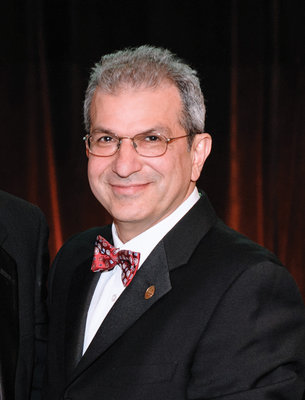On the windowsill of Nariman Farvardin’s office, with its gorgeous view of Manhattan, the Hudson River, and downtown Hoboken, there is a picture frame containing a long list of bulleted items. Some are green, some are red, and others blue. It seems an odd thing to frame unless you’ve observed the approach that Farvardin, the seventh president of Stevens Institute of Technology, brings to his work.
“The red things are things we’re not working hard enough on, the green ones are things I think we’re doing pretty well with, and the blue are things that are somewhere in between,” he said. “I am focused like a laser beam.”
So it’s not that odd to frame a to-do list and stick on your windowsill for all to see. Not when you’re Farvardin, who said in an interview recently that his most enjoyable hobby isn’t a hobby at all, it’s his work.
“My work doesn’t come separately from life, they aren’t separate things,” said the Iranian-born academic, who holds three degrees in electrical engineering from the Rensselaer Polytechnic Institute in upstate New York. “I get an enormous amount of gratification from my job. Outside of work, I basically work.”
“The success of Stevens depends on the success of Hoboken, and the relationship we share.” – President Nariman Farvardin
____________
“…in ways not realized”
Since Farvardin joined Stevens in the summer of 2011 he has engaged in an aggressive strategic planning campaign which, by the end of its planned ten year duration, is intended to catapult Stevens to the pinnacle of technologic academia, where the school might be ranked amongst the giants of the field: the Massachusetts Institute of Technology, Caltech, Stanford and Farvardin’s own alma mater.
Asked why he decided to leave his previous post, as the senior vice president for academic affairs at the University of Maryland, Farvardin said at Stevens he saw an opportunity for success based on resources that few other schools have had their disposal.
“There is so much potential here,” he said. “There is a culture of knowledge with an emphasis on innovation and entrepreneurship, and then there are other factors, like our proximity to New York City, our strong alumni community, and our beautiful facilities. I saw an opportunity to advance this school in stature and prestige in ways not yet realized.”
But Farvardin is also conscious of the challenges associated with his grand plan. He’s adopted the use of Stevens’ motto, per aspera ad astra (‘Through adversity, to the stars’), and has spoken of engaging the entire community in the struggle to grow.
“This is an extremely bold plan for this institution,” he said. “But it is a grassroots effort, and because of that I believe it will work. We are engaging faculty, staff, trustees, students, alumni and members of the administration, and simply asking them ‘Where do we want to go?’”
In the packet summarizing the strategic plan, usually presented to potential donors, Farvardin states a goal nothing short of, well, shooting for the stars.
“Our mission ignites our work: To inspire, nurture and educate leaders for tomorrow’s technology-centric environment while contributing to the solution of the most challenging problems of our time,” he wrote.
Working with Hoboken
One such problem of tomorrow that Stevens faculty and students have already spent a considerable amount of time tackling is one that hits close to home for many Hoboken residents: climate change.
Since 2011, when Hurricane Irene set the stage for a flooding issue that intensified in the city since Hurricane Sandy struck in 2012, teams at Stevens have worked on projects aimed at learning more about these new types of storms, and how best to protect against them.
Dr. Alan Blumberg, a storm scientist and director of the school’s Center for Maritime Systems, has been saying storms are getting more violent and more frequent for years. He predicted Hurricane Sandy’s intensity 72 hours before it hit landfall, thanks to the state-of-the-art sensor system he and his colleagues have deployed throughout the area, from the Hudson River to the Jersey Shore. The systems allow scientists to use data to project the damage of a storm a few days before it hits, and according to Blumberg, the data rarely lies.
“Three days before Sandy, we were predicting that about 11 feet of water would hit Sinatra Drive,” he said in July. “And sure enough there were about 11 feet.”
Other students are working on engineering projects, similar to the work of a Dutch design firm currently building a plan to protect Hoboken, that fall in line with Mayor Dawn Zimmer’s vision of a resilient Hoboken that might serve as a model for urban storm protection around the country. Farvardin, an outspoken supporter of Zimmer, said that Hoboken and Stevens must work together to protect the city, or else the future of both entities could be endangered.
“We must use our research tools to help the city, to figure out hazard mitigation strategies, to gain knowledge about when and where these storms will hit and how to fend against them, and how the city can prepare itself,” he said. “I am very conscious of the fact that the success of Stevens depends on the success of Hoboken, and the relationship we share.”
Dean DeChiaro may be reached at deand@hudsonreporter.com
